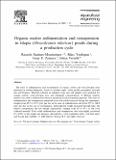| dc.contributor.author | Jiménez, Ricardo | |
| dc.contributor.author | Verdegem, Marc | |
| dc.contributor.author | Zamora Castro, Jorge | |
| dc.contributor.author | Verreth, Johan | |
| dc.date.accessioned | 2020-10-06T14:44:34Z | |
| dc.date.available | 2020-10-06T14:44:34Z | |
| dc.date.issued | 2002-07-01 | |
| dc.identifier.other | PII: S0144-8609(01)00086-3 | |
| dc.identifier.uri | http://hdl.handle.net/11056/18300 | |
| dc.description.abstract | The rates of sedimentation and resuspension of organic carbon and total nitrogen were
measured in earthen fishponds, based on nutrient input, water quality parameters and fish size and biomass. Material collected in sediment traps and soil samples were analyzed for organic carbon, total nitrogen, iron and aluminum concentrations. A dilution analysis method was used to differentiate between sedimented and resuspended particles. The rates of sedimentation and resuspension estimated from total solids increased during the experiment, ranging from 49.8 to 218.1 g/m2 per day in the case of sedimentation and from 39.2 to 160.0 g/m2 per day in the case of resuspension. Although fish weight increased through time, the relative resuspension did not change significantly, ranging from 42 to 47% of the total collected material. Total solids sedimentation and resuspension rates were highly correlated (P 0.01) to fish weight and biomass, chlorophyll-a, total suspended solids, total feed input and Secchi disk visibility. | es_ES |
| dc.description.abstract | Las tasas de sedimentación y resuspensión de carbono orgánico y nitrógeno total se midieron en estanques de peces de tierra, con base en el aporte de nutrientes, parámetros de calidad del agua y tamaño y biomasa de los peces. El material recolectado en trampas de sedimentos y muestras de suelo se analizaron para determinar las concentraciones de carbono orgánico, nitrógeno total, hierro y aluminio. Se utilizó un método de análisis de dilución para diferenciar entre partículas sedimentadas y resuspendidas. Las tasas de sedimentación y resuspensión estimadas a partir de sólidos totales aumentaron durante el experimento, oscilando entre 49.8 y 218.1 g / m2 por día en el caso de sedimentación y de 39.2 a 160.0 g / m2 por día en el caso de resuspensión. Aunque el peso de los peces aumentó con el tiempo, la resuspensión relativa no cambió significativamente, oscilando entre el 42 y el 47% del material total recolectado. Las tasas de sedimentación y resuspensión de sólidos totales estuvieron altamente correlacionadas (P 0.01) con el peso y biomasa de los peces, clorofila-a, sólidos suspendidos totales, entrada de alimento total y visibilidad del disco Secchi. | es_ES |
| dc.description.sponsorship | Universidad Nacional, Costa Rica | es_ES |
| dc.language.iso | eng | es_ES |
| dc.rights | Acceso abierto | es_ES |
| dc.source | Aquacultural Engineering vol.26 1-12 2002 | es_ES |
| dc.subject | FISH POND | es_ES |
| dc.subject | SEDIMENT | es_ES |
| dc.subject | SEDIMENTATION RATE | es_ES |
| dc.subject | RESUSPENSION RATE | es_ES |
| dc.subject | TOTAL NITROGEN | es_ES |
| dc.subject | ORGANIC CARBON | es_ES |
| dc.subject | PECES | es_ES |
| dc.subject | SEDIMENTACIÓN | es_ES |
| dc.subject | ESTANQUES PISCICOLAS | es_ES |
| dc.subject | CULTIVO DE PECES | es_ES |
| dc.title | Organic matter sedimentation and resuspension in tilapia (Oreochromis niloticus) ponds during a production cycle | es_ES |
| dc.type | http://purl.org/coar/resource_type/c_6501 | es_ES |
| bk-old-una.estado | | |
| dc.description.procedence | Escuela de Ciencias Biológicas | es_ES |

